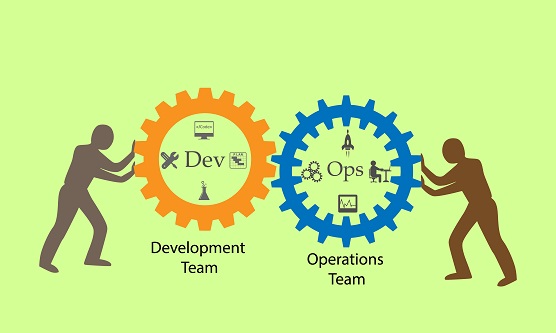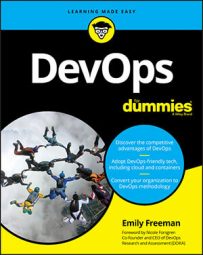 ©Shutterstock/Ashalatha
©Shutterstock/AshalathaDevOps helps you accept constant change
The tech landscape is an ever-changing environment. Some languages evolve and new ones are created. Frameworks come and go. Infrastructure tooling changes to meet the ever-growing demands for hosting applications more efficiently and delivering services more quickly. Tools continue to abstract low-level computing to reduce engineering overhead.The only constant is change. Your ability to adapt to that change will determine your success as an individual contributor, manager, or executive. Regardless of the role you currently fill at your company or hope to eventually play, it is vital to adapt quickly and remove as much friction from growth as possible. DevOps enables you to adapt and grow by improving communication and collaboration.
DevOps embraces the cloud
The cloud isn’t the future; it’s now. Although you may still be transitioning or not yet ready to move, realize that the cloud is the way forward for all but a few companies. It gives you more flexibility than traditional infrastructure, lowers the stress of operations, and (usually) costs significantly less because of a pay-as-you-go pricing structure.Public, private, and hybrid clouds give you endless possibilities to run your business better. The ability to spin up (launch) resources within minutes is something most companies have never experienced prior to the cloud.
This agility provided by the cloud goes hand in hand with DevOps. Omri Gazitt from Puppet, a company focused on automation and configuration management, put it best: “As organizations move to the cloud, they are revisiting their core assumptions about how they deliver software.”
With the cloud, APIs connect every service, platform, and infrastructure tool so that you can manage your resources and application seamlessly. As you migrate to the cloud, you can reevaluate past architecture decisions and slowly transition your application and system to be cloud-native, or designed with the cloud in mind.
DevOps helps you hire the best
Because of increased demand, great engineers are scarce. There simply aren’t enough engineers to fill all the jobs currently open or to meet market demand over the next decade and beyond. Although finding engineers can be difficult, it’s not impossible, especially if you focus on discovering engineers who embrace curiosity and aren’t afraid to fail. If you implement DevOps in your overall engineering culture, you can level up engineers and train them in the methodology and technology that supports continuous improvement.It’s difficult to measure potential in an interview. Usually, talent whispers. The most talented engineers typically aren’t gregarious or braggarts; they let their work speak for them. DevOps enables you to listen more closely to the personal and professional interests of the engineers you interview.
Try choosing candidates based on their level of curiosity, communication skills, and enthusiasm. Those qualities can see your team through the troughs of fear, uncertainty, and doubt. They can carry the team through hard decisions, made within constraints, in their attempt to solve difficult problems.
You can teach someone a skill, but teaching someone how to learn is an entirely different matter. The learning culture you create in your DevOps organization enables you to prioritize a growth mindset over technical prowess. In DevOps, hiring for the team is critical. Every individual is a piece of a whole, and the team must have balance holistically. Achieving this balance means that sometimes you don’t hire the “best” engineer, you hire the best engineer for the team.
When you hire for the DevOps team you can, like draft horses yoked together, pull more weight than you could individually. With DevOps, you can multiply the individual components of your team and, as a whole, create a powerhouse of a team.
DevOps keeps you competitive
The yearly State of DevOps Report released by DevOps Research and Assessment (DORA) makes it clear: Companies across the world are using DevOps to adjust their engineering practices and are reaping the benefits. They see increases in engineering production and reductions in cost. With DevOps, these companies are shifting from clunky processes and systems to a streamlined way of developing software focused on the end user.DevOps enables companies to create reliable infrastructure and utilize that infrastructure to release software more quickly and more reliably. The bottom line is this: High-performing organizations use DevOps, and they’re crushing their competition by increasing their deployment frequency and significantly decreasing their failures that occur because of changes in the system.
If you want to compete, you must adopt the solid DevOps methodologies. Maybe not all of them, and definitely not all at one time — but the time to wait and see whether DevOps is worthwhile has passed.
DevOps helps solve human problems
Humans have reached a point in our evolution at which technology is evolving faster than our brains. Thus the greatest challenges humans face are due to human limitations — not the limitations of software or infrastructure. Unlike other software development methodologies, DevOps focuses holistically on your sociotechnical system.Embracing DevOps requires a shift in culture and mindset. But if you achieve a DevOps culture and mindset, you and your organization reap almost limitless benefits. When engineers are empowered to explore, free of the pressure and fear of failure, amazing things happen.
Engineers discover new ways to solve problems. They approach projects and problems with a healthy mindset and work together more fluidly, without needless and negative competition.
DevOps challenges employees
DevOps accelerates the growth of individual engineers as well as that of the engineering team as a whole. Engineers are smart people. They’re also naturally curious. A great engineer who embraces a growth mindset needs new challenges after mastering a particular technology, tool, or methodology or they often feel stagnant.They need to feel as if their brain and skill sets are being stretched — not to the point of being overwhelmed or stressed, but enough to feel that they’re growing. That is the tension described by Dan Pink in Drive. If you can strike that balance, your engineers will thrive — as individuals and as a team.
The methodology of DevOps promotes T-shaped skills, which means that engineers specialize in one area with deep knowledge and have a broad understanding of many other areas. This approach allows engineers to explore other areas of interest.
Perhaps a Python engineer has an interest in cloud infrastructure, for example. No other engineering methodology permits and encourages engineers to explore as much as DevOps does, and it’s a huge contributor to hiring and retaining talent.
DevOps bridges gaps
One of challenges of modern technology companies is this gap between the needs of the business and the needs of engineering. In a traditional company, with traditional management strategies, a natural friction exists between engineering and departments like marketing, sales, and business development. This friction stems from a lack of alignment. Each department is measured by different indicators of success.DevOps seeks to unify each department of a business and create a shared understanding and respect. That respect for each other’s jobs and contributions is what allows every person in the company to thrive. It removes the friction and improves acceleration.
Think about a team of sled dogs. If each dog is moving in separate directions, the sled goes nowhere. Now imagine the dogs working together, focused on moving forward — together. When you lack friction internally, the only challenges you face are external, and external challenges are almost always more manageable than internal strife.
DevOps lets you fail well
Failure is inevitable. It’s simply unavoidable. Predicting every way in which your system can fail is impossible because of all the unknowns. (And it can fail spectacularly, can’t it?) Instead of avoiding failure at all costs and feeling crushed when failure does occur, you can prepare for it. DevOps prepares organizations to respond to failure, but not in a panicky, stress-induced way.Incidents will always involve some level of stress. At some point along your command structure, an executive is likely to scream at the money being lost during a service outage. But you can reduce the stress your team experiences by using failure as a way of learning and adapting your system to become more resilient.
Each incident is an opportunity to improve and grow, as individuals and as a team.
DevOps embraces kaizen, the art of continuous improvement. When your team experiences flow in their work, they can make tiny choices every day that contribute to long-term growth and, ultimately, a better product.DevOps lets you continuously improve
Continuous improvement is a key ingredient in DevOps. Use the visualization of a never-ending cycle when applying DevOps to your organization. The cycle shouldn’t invoke fears through thoughts of Sisyphus, pushing a boulder up a hill for all eternity. Instead, think of this cycle as movement, like a snowball rolling downhill, gathering momentum and mass.As you adopt DevOps and integrate more and more of its core tenets into your everyday workflow, you’ll witness this acceleration first-hand. The cycle of continuous improvement should always center around the customer. You must continuously think about the end user and integrate feedback into your software delivery life cycle.
Fundamental to this cycle is CI/CD. Adopting CI/CD isn’t an all-or-nothing requirement of DevOps; instead, it’s a slow process of implementation. You should focus on mastering continuous integration first. Encourage engineers to share code freely and merge code frequently. This approach prevents isolation and silos from becoming blockers in your engineering organization.
After your organization masters continuous integration, move on to continuous delivery, the practice of automating software delivery. This step requires automation because code will move through multiple checks to ensure quality. After all your code is secure and accessible in a source code repository, you can begin to implement small changes continuously. Your goal is to remove manual barriers and improve your team’s ability to discover and fix bugs without customer impact.
DevOps automates toil
Acceleration and increased efficacy are at the core of the DevOps methodology. By automating labor-intensive manual processes, DevOps frees engineers to work on projects that make the software and systems more reliable and easily maintained — without the chaos of unexpected service interruptions.Site reliability engineering (SRE) deals with toil, which is the work required to keep services up and running but is manual and repetitive. Toil can be automated and lacks long-term value. Perhaps most important of all, toil scales linearly, which limits growth. Note that toil doesn’t refer to the overhead of administrative necessities such as meetings and planning. This type of work, if implemented with a DevOps mentality, is beneficial to the long-term acceleration of your team.
One of the core tenets of tooling your DevOps practice is automation. You can automate your deployment pipeline to include a verbose test suite as well as other gates through which code must pass to be released. In many ways, SRE is the next logical step in the evolution of DevOps and should be your next step after you and your organization master the core concepts of DevOps and implement the practice in your team.
DevOps accelerates delivery
The software delivery life cycle has evolved from the slow and linear Waterfall process to an agile and continuous loop of DevOps. You no longer think up a product, develop it fully, and then release it to customers, hoping for its success.Instead, you create a feedback loop around the customer and continuously deliver iterative changes to your products. This connected circuit enables you to continuously improve your features and ensure that the customer is satisfied with what you’re delivering.
When you connect all the dots and fully adopt DevOps in your organization, you watch as your team can deliver better software faster. The changes will be small at first, just like the changes you release. But over time, those seemingly insignificant changes add up and create a team that accelerates its delivery of quality software.

